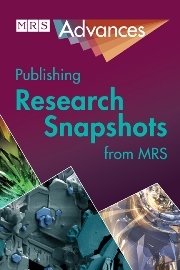Article contents
Stress Induced Vacancy Clustering Mechanism of Resistive Switching inHafnium Oxides
Published online by Cambridge University Press: 01 February 2016
Abstract
Reversible changes in the conductivity of HfO2 dielectric film betweenhigh and low resistive states of a metal-insulator-metal memory cell wereattributed to the formation of oxygen vacancies and their clustering across theinsulator layer. In this study we present an innovative model which includesgeneration of two-charged states of oxygen vacancies at the anode, theirdiffusion to the cathode, transformation to one-charged state, and then toneutral vacancies. Vacancy clusters in the insulator layer are built from onlyneutral vacancies, while the kinetics of the clustering process is controlled bydiffusion of mobile one-charged state vacancies. Resistive switching is treatedas the formation of critical size vacancy cluster which provides continuousconductive path through the dielectric layer. Good agreement between theexperimental data and the theoretical bias and temperature dependences for thedelay time was obtained.
- Type
- Articles
- Information
- Copyright
- Copyright © Materials Research Society 2016
References
REFERENCES
- 1
- Cited by


